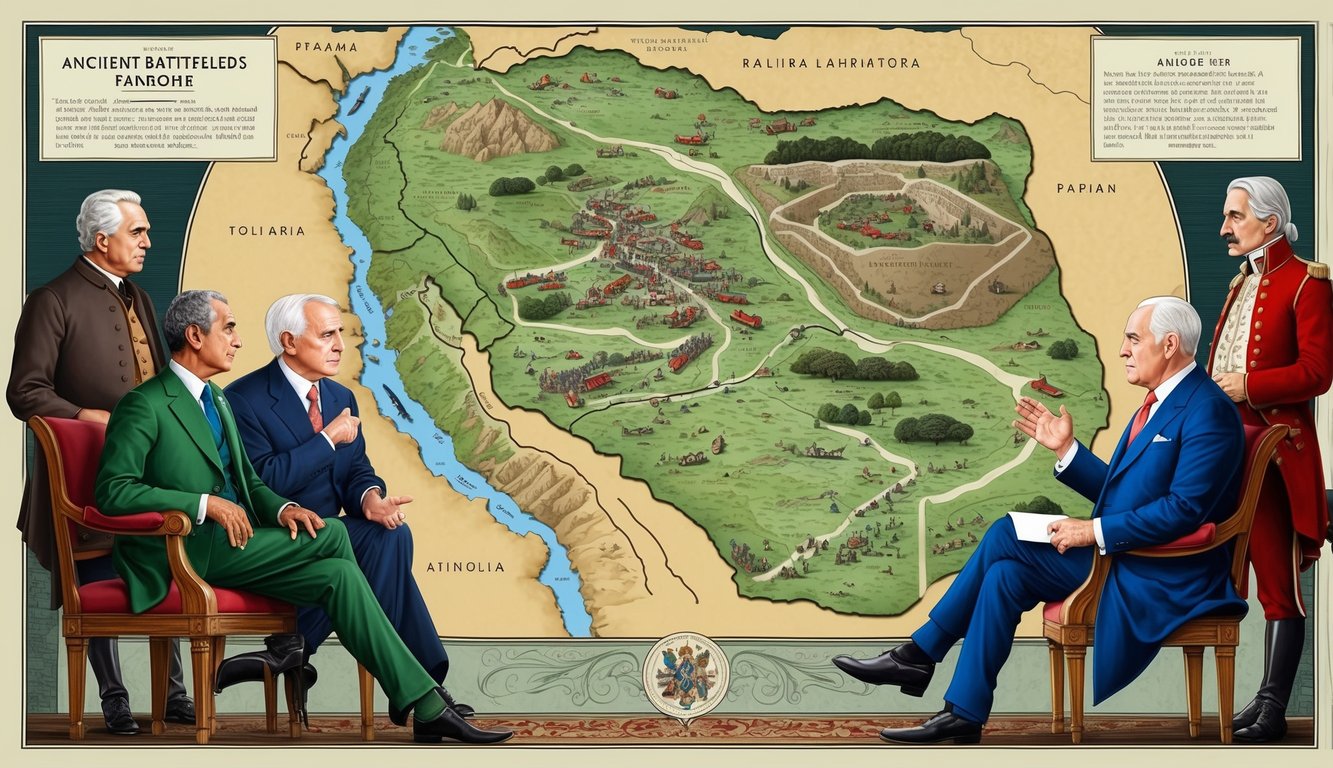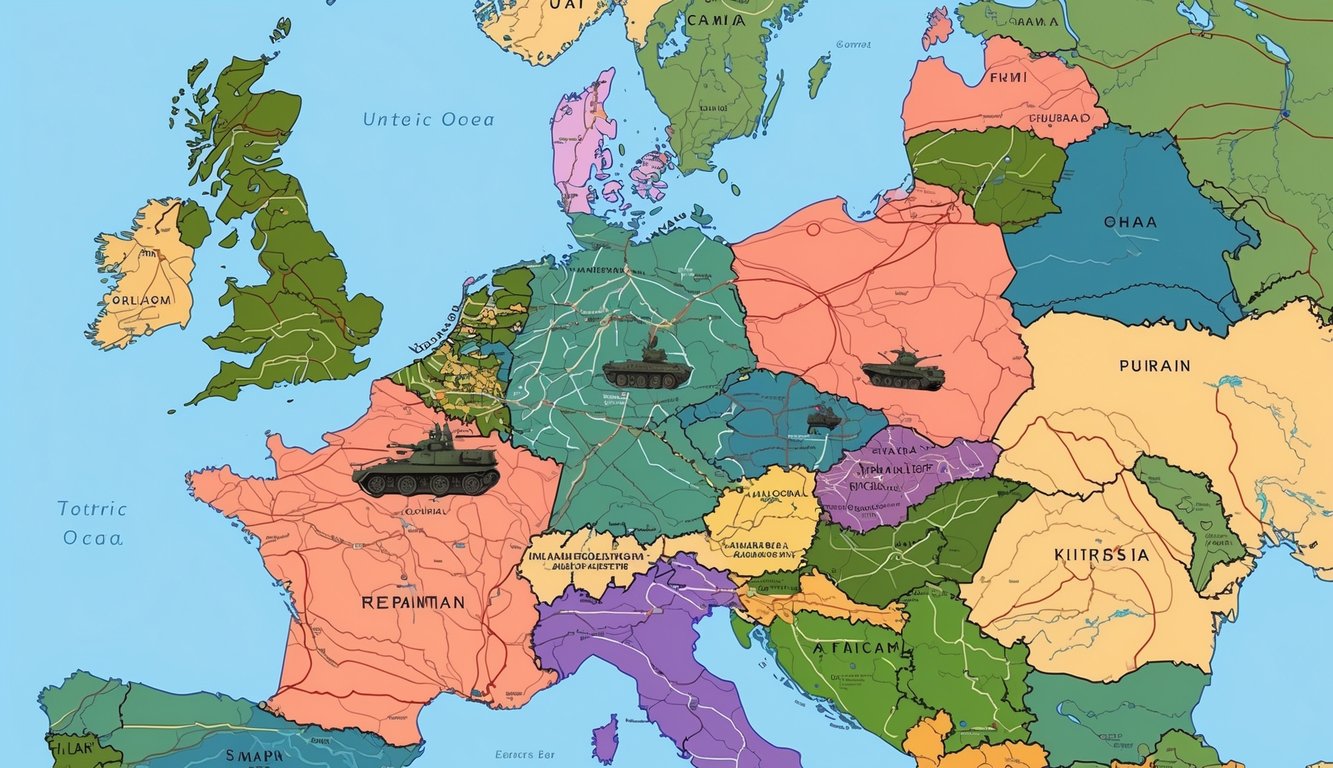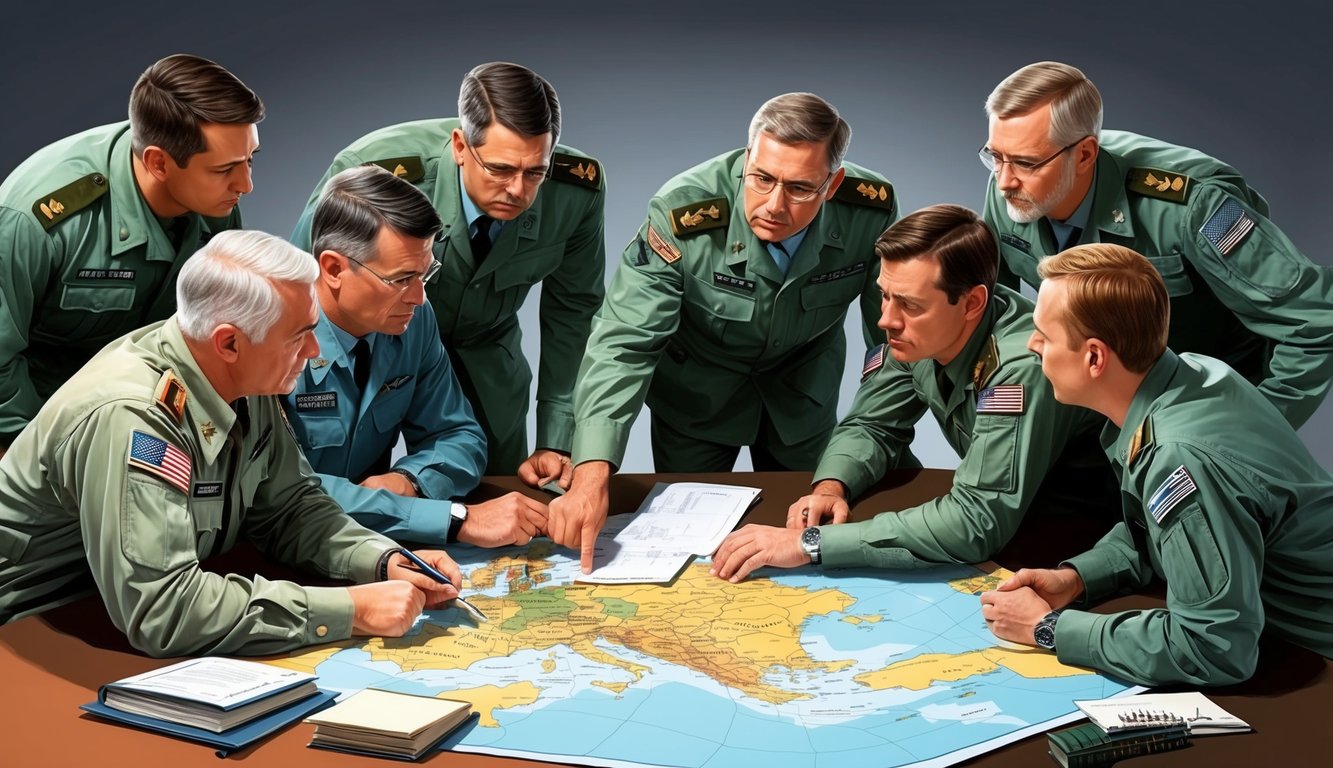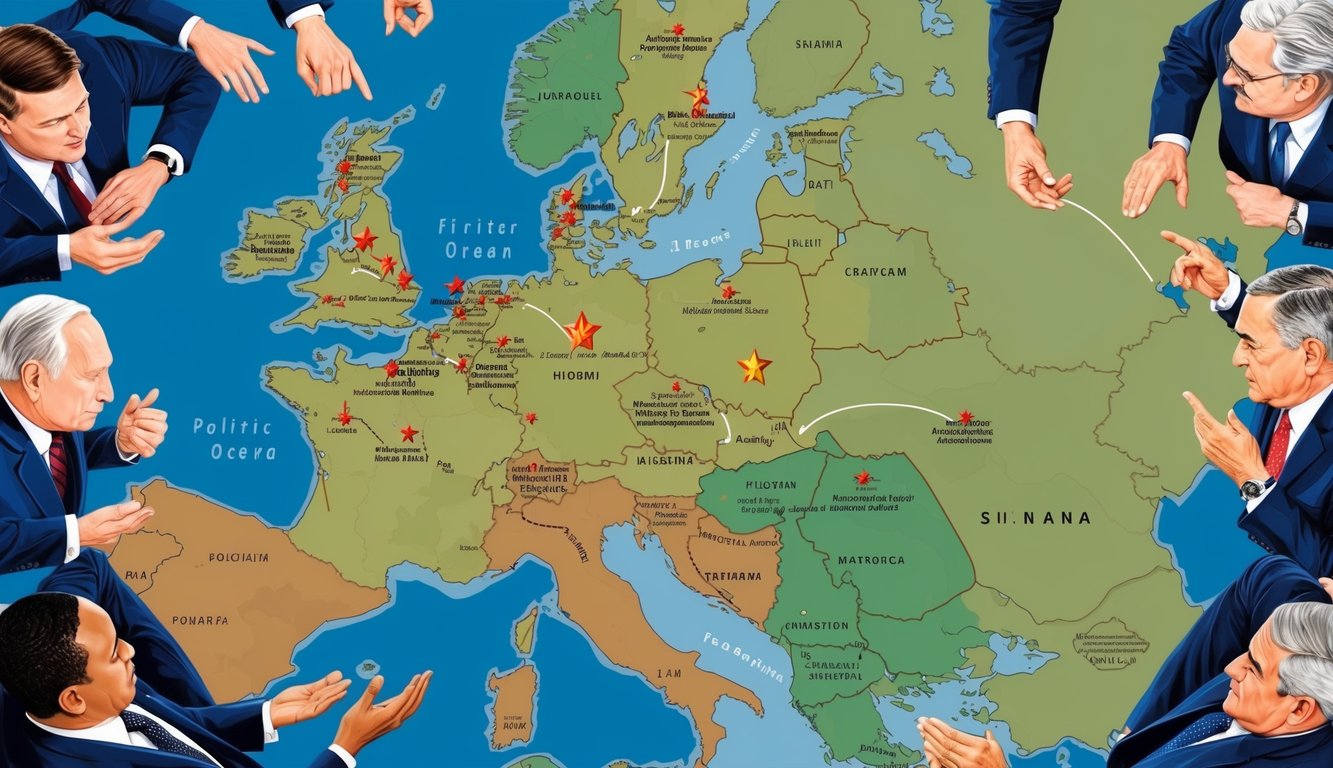Military strategy and political decision-making are closely intertwined, influencing historical trajectories and international relations.
Actions taken in military settings can have significant repercussions within political discourse. Military strategies can shift political landscapes by changing power balances, affecting public perceptions, and necessitating diplomatic realignments.
Military triumphs or setbacks can directly impact political backing for leaders.
A successful military endeavor can bolster a government’s legitimacy, whereas a failed campaign can lead to political unrest.
History provides numerous examples of this dynamic, from ancient Rome through to contemporary conflicts.
This relationship is bidirectional as well.
Political ambitions often shape military objectives, which can create friction between political authorities and military leaders.
This interaction underscores the intricate nature of decision-making in national security and foreign affairs.
Key Takeaways
- Military strategies can profoundly affect political environments and leadership authority.
- Political ambitions frequently shape military objectives and tactics.
- The interaction between military and political spheres is crucial for global stability and diplomatic relations.
Historical Context of Military Strategy

Throughout history, military strategy has significantly influenced political decisions.
This evolution reflects advancements in technology, geopolitical contexts, and societal values.
Major conflicts have transformed how countries approach warfare and diplomacy.
World Wars: Shifting Political Paradigms
World War I introduced trench warfare and the concept of total war.
Societies mobilized on an unprecedented scale, blurring the boundaries between civilian and military efforts.
Political leaders faced challenges stemming from massive casualties and the necessity of forming alliances.
World War II accelerated technological advancements, with the atomic bomb reshaping global power structures.
The emergence of air power and mechanized warfare further intertwined political decisions with military capabilities.
These wars redefined global relations, leading to the creation of institutions like the League of Nations and the United Nations, reflecting an increased recognition of military strategy’s global political ramifications.
Cold War: Balancing Deterrence and Diplomacy
The Cold War era established nuclear deterrence as fundamental to military strategy.
Superpowers engaged in an arms race, with political decisions largely shaped by the concept of mutually assured destruction.
Proxy conflicts became prevalent as direct confrontations posed significant risks.
The Vietnam, Korean, and Afghan wars exemplified how military actions aligned with larger geopolitical objectives, compelling leaders to reconcile strategies of containment with the threat of escalation.
During this time, advancements in space and intelligence capabilities grew vital, with political arenas increasingly relying on military technology for surveillance and communication.
Arms control agreements emerged as crucial diplomatic instruments, directly linking military strategy to international political considerations.
Vietnam and Gulf Wars: Lessons Learned
The Vietnam War posed challenges to conventional military approaches, demonstrating how guerrilla tactics could thwart a militarily superior force.
As the conflict extended, political support diminished, underlining the significance of public sentiment in military strategy.
Extensive media coverage brought the realities of war into households, thereby shaping political narratives.
The conclusion of the war prompted a thorough reevaluation of U.S. foreign policy and military doctrine.
The Gulf War illustrated the potential of precision warfare and coalition-making to achieve specific political aims.
The rapid deployment of overwhelming force showcased how military actions could alter perceptions of 21st-century warfare, reaffirming the U.S.’s status as a principal military power.
These engagements emphasized the necessity of clearly defined political objectives in military strategies, influencing discussions about just war theory and the deployment of force in international relations.
Key Military Strategies and Their Political Influence
Military strategies wield significant influence over political frameworks.
Approaches such as counterinsurgency, cyber warfare, and nuclear deterrence have enduring implications for global politics and diplomacy.
Counterinsurgency and Nation-Building
Counterinsurgency tactics aim to win support while combating insurgent forces.
These methods often heavily influence political decision-making, frequently resulting in long-term commitments to foreign interventions.
A prominent example is U.S. involvement in Afghanistan.
Political leaders are tasked with assessing the costs and benefits of nation-building initiatives.
These strategies can:
- Stabilize unstable regions
- Foster new economic partnerships
- Enhance diplomatic relations
However, they also carry the risk of extended military operations and domestic political backlash.
The governmental approach to counterinsurgency can have lasting impacts on foreign policy.
Cyber Warfare and the New Battleground
Cyber warfare has transformed military strategy and political decision-making.
We now navigate a reality where conflicts can emerge in digital arenas, threatening critical infrastructure and national security.
Key elements of cyber warfare encompass:
- State-backed hacking
- Disinformation efforts
- Safeguarding digital assets
Political authorities must swiftly adapt to these changing threats.
Cyber capabilities increasingly factor into diplomatic discussions and strategic deterrence, with a nation’s commitment to cybersecurity influencing its geopolitical standing and ability to safeguard interests.
Deterrence and the Role of Nuclear Weapons
Nuclear deterrence remains foundational for military strategy among nuclear-capable countries.
The mere existence of these arsenals significantly shapes global politics and diplomatic relationships.
Nuclear strategies have implications for:
- Arms control negotiations
- Non-proliferation initiatives
- Strategic alliances
Political choices regarding nuclear stockpiles can escalate or mitigate tensions between states.
A nation’s approach to nuclear arms fundamentally influences its diplomatic leverage and security assurances, necessitating a careful balancing of nuclear deterrence’s strategic advantages against proliferation and accident risks.
Military and Political Leadership Interplay
The interplay between military and political leaders is complex and fluid, shaping major decisions regarding war, peace, and national security.
The balance of authority and influence between these two entities can vary greatly, depending on the context and individuals involved.
Decision-Making Under US Presidents
Different presidents exhibit diverse approaches to military decision-making.
For instance, George W. Bush initially relied heavily on his military advisors at the beginning of the Iraq War.
However, as the conflict persisted, he increasingly took a proactive stance, advocating for the 2007 troop surge against military counsel.
Conversely, Barack Obama was known for rigorously evaluating military strategies and seeking multiple perspectives, occasionally leading to tensions with high-ranking military officials who felt their expertise was undervalued.
This demonstrates how presidential leadership styles significantly influence the weighing of military advice in pivotal moments.
Civil-Military Relations and Decision-Making
The concept of “civilian control of the military” is essential in democracies yet often becomes complicated.
Military leaders may advocate for more assertive actions, while elected officials are concerned about the associated political repercussions.
Occasionally, military leaders may publicize their views, thus exerting pressure on civilian authorities, as witnessed during Obama’s Afghanistan strategy review.
This highlights the reality that military decisions are shaped by the dynamic between military and civilian leadership.
Ethical Considerations in Leadership
In life-threatening situations, ethical implications are profound.
Both military and political leaders encounter significant moral dilemmas.
Military leaders must balance operational success with the safety of troops and civilian populations.
They operate within the laws of warfare, yet face numerous ambiguous situations.
Political figures also wrestle with the necessity of justifying military actions to the public, weighing national interests against possible humanitarian costs.
It’s vital to recognize that such ethical concerns may create tensions between political and military leadership, particularly when values or priorities conflict.
Influence of Military Strategy on Political Aims

Military strategy and political decision-making are deeply interconnected.
Battlefield decisions can influence electoral outcomes, international partnerships, and a nation’s core interests.
Determining National Interest
The national interest of a country underpins its military strategy and political objectives.
Leaders must navigate the balance between security imperatives and economic as well as diplomatic objectives, often necessitating difficult sacrifices.
Military endeavors can either advance or obstruct political ambitions.
A successful mission may enhance a leader’s popularity and fortify their negotiating position, while a failed operation can damage credibility domestically and internationally.
In strategic planning, it’s crucial to contemplate long-term effects.
Will intervention promote stability or instigate prolonged discord? How will it influence relationships with allies and adversaries alike?
Election Cycles and Military Actions
Military operations are often timed to coincide with political calendars.
You may notice heightened military activity in response to impending elections as leaders seek to project strength regarding national security.
Occasionally, administrations postpone significant strategic shifts until post-election to mitigate political risks, which can affect military efficacy and extend conflicts.
Voter reactions to military actions can sway electoral outcomes.
A swift military success may enhance approval ratings, whereas a protracted conflict could diminish public support.
Military leaders are required to balance these political realities with the imperative of operational readiness and troop morale.
Alliances and International Cooperation
Military strategy influences and is informed by international alliances.
Solid partnerships can deter aggression and provide pivotal support during crises.
Joint military exercises and collaborative operations foster trust among nations and signal your country’s commitments and priorities to the global community.
Military collaboration can bolster deeper political engagement.
Mutual security concerns often lead to economic cooperation and diplomatic alignment.
Conversely, military alliances may constrict political options, compelling nations to support allies in conflicts that do not align with national interests.
Impacts on National Security and Global Politics
Military strategy profoundly impacts national security and global political dynamics.
Its effects reverberate through alliances, diplomatic relationships, and public perceptions, shaping how countries react to threats.
The Role of Alliances and Coalitions
Military alliances and coalitions are vital for global security.
Being part of a robust alliance enhances your country’s military capabilities.
Take NATO, for example; it serves as a formidable deterrent against potential aggressors.
These partnerships facilitate information sharing and joint training exercises, enhancing overall preparedness.
However, alliances also present challenges.
You may find that conflicts arise in which your interests are not directly threatened.
Moreover, there’s the risk of excessive dependence on allies for defense, which could undermine your defense capabilities.
Multinational coalitions, as seen in the Gulf War, can yield significant achievements for specific missions, combining diverse military strengths and expertise.
Nevertheless, managing these coalitions can introduce complexities, such as language barriers and differing military protocols.
Diplomacy versus Military Operations
The balance between diplomacy and military action is delicate.
A nation’s military strength can enhance diplomatic authority in negotiations.
The possibility of a credible military threat may prevent conflict without the need for direct engagement.
However, an overreliance on military solutions may prove counterproductive, damaging international relations and complicating diplomatic efforts.
Effective leadership generally strikes a balance between:
- Employing diplomacy as the primary strategy
- Reserving military measures as a last resort
- Incorporating “soft power” alongside military capabilities
Interestingly, military operations can also yield diplomatic openings, such as humanitarian missions that enhance a country’s global standing and pave the way for diplomatic dialogues.
Public Opinion and Accountability
Public backing is crucial for military initiatives.
In democratic contexts, military decisions are often significantly swayed by public sentiment.
Leaders must articulate their strategies to voters, influencing choices related to troop deployments and defense budgets.
Media plays a powerful role in shaping public perceptions.
Continuous news coverage and social media ensure military actions receive constant scrutiny.
This transparency fosters accountability but can also compromise operational secrecy.
Public opinion can swing quickly:
- Swift victories tend to bolster support
- Prolonged conflicts usually diminish it
- Civilian casualties can lead to widespread public dissent against military engagement
To retain public confidence, military and political leaders should:
- Clearly communicate objectives and progress
- Be open about costs and potential risks
- Maintain ethical conduct during operations
Finding a balance between military imperatives and public accountability is a persistent challenge in contemporary conflicts.
Advancements in Military Technology
The rapid evolution of military technology is reshaping warfare while influencing global political dynamics.
Innovations impact military efficacy, defense strategies, and collaborative operations.
Modern Warfare and Military Effectiveness
Modern conflict is markedly different from previous engagements.
The integration of drones and AI-driven systems is increasingly prevalent on battlefields.
Such technologies elevate precision and mitigate risks to personnel.
Cyber capabilities also hold a central position in contemporary warfare, allowing for the disruption of adversarial communications or infrastructures without physical confrontation.
This evolution in warfare dynamics alters how military effectiveness is assessed.
Advancements in robotics are transforming combat operations.
Expect to see autonomous systems engaged in reconnaissance and even combat missions in the foreseeable future.
Defense Strategies and Force Structure
Your military strategy is likely geared toward adaptability and rapid response.
Cutting-edge technology enables the deployment of smaller yet highly effective forces.
Force structures are evolving to include new specializations:
- Units focused on cyber warfare
- Drone operation teams
- Experts in AI technology
You may observe a trend towards multi-domain operations, facilitating seamless action across land, sea, air, space, and cyberspace.
Additionally, financial priorities are shifting, with a notable increase in investments directed towards advanced technologies and training.
The Future of Joint Operations
Joint operations are becoming more interconnected than ever before, with various branches collaborating in unprecedented manners.
Real-time data sharing has revolutionized operations.
Imagine a ground soldier receiving immediate intelligence from an orbiting satellite.
Furthermore, virtual and augmented reality are transforming training methodologies, allowing complex scenario practice without physical deployment.
International partnerships are leveraging technology to bridge language and cultural barriers, enhancing interoperability and solidifying alliances.
As military technology progresses, new ethical frameworks will likely emerge.
There will continue to be discussions regarding the use of autonomous weapons and AI in combat scenarios.
Trends and Future Outlook

Military strategy and political decision-making will keep evolving in response to global shifts.
Emerging technologies and changing geopolitical landscapes are reshaping military operations and the way political leaders tackle security challenges.
Predicting Future Trends in Military Strategy
Expect to see the adaptation of military doctrine to address new threats and capabilities.
Cyber warfare and artificial intelligence are poised to take on more significant roles in upcoming conflicts.
An increased emphasis on space-based assets and autonomous systems is anticipated.
Military planners will prioritize agility and rapid deployment.
Traditional force structures may give way to more nimble, multi-domain units, and you may notice a greater integration of both conventional and special operations forces.
Decision-making procedures will increasingly incorporate data analysis and predictive modeling, potentially enabling quicker and more informed determinations in complex scenarios.
Military Institutions and Changing Operational Environments
You will likely witness military institutions adapting to confront new challenges.
Training curricula will integrate virtual and augmented reality to prepare forces for a variety of operational contexts.
Expect more joint exercises between different military branches and multinational task forces.
Enhancing interoperability will be essential as militaries collaborate to tackle global threats.
Climate change will influence operational contexts, with militaries adapting to extreme weather conditions and emerging conflicts over resources.
Operations in the Arctic region may become increasingly prevalent due to melting ice.
As cities grow more strategically significant, advancements in urban warfare tactics are expected.
Military planners will prioritize minimizing civilian impacts in densely populated settings.
The Influence of Governance and Legislation
Closer collaboration between military leaders and civilian policymakers is expected.
This partnership will aim to align strategic objectives with political aims more effectively.
Legislative oversight of military actions may intensify, leading to more discussion regarding the implementation of emerging military technologies such as autonomous systems.
Governments are likely to update legal frameworks to address new forms of warfare, particularly in cyberspace.
Initiatives to establish international norms governing military conduct in digital arenas are anticipated.
Budget allocations may shift toward research and development of next-gen technologies, impacting both military structures and procurement systems.
Public opinion will remain a driving force influencing military decisions.
Expect increasing emphasis on transparency and accountability in military actions communicated to the populace.
Frequently Asked Questions

Military strategy notably influences political decisions and outcomes, affecting everything from negotiations to policy creation, with historical contexts continuing to shape modern practices.
How does military strategy shape the outcomes of political negotiations?
Military strategy establishes the framework for political discussions.
A robust military stance can enhance leverage during negotiations, while a weak military condition may compel concessions.
The availability and positioning of military forces can dictate the nature of peace agreements or ceasefire terms, influencing the negotiating power of each side.
What role does military theory play in the decision-making process of political leaders?
Military theory offers frameworks for political leaders to evaluate risks and prospects.
Concepts like deterrence and containment play crucial roles in informing foreign policy decisions.
These frameworks assist leaders in predicting potential outcomes for their choices and decipher how military actions might affect diplomatic relations and political pursuits.
In what ways has historical military strategy influenced modern political policies?
Legacy military strategies continue to inform current political perspectives.
You can observe reflections of historical practices in contemporary defense policies and international relations.
The Cold War’s nuclear deterrence strategy, for instance, continues to shape how states address global security challenges, while ancient siege tactics have morphed into modern economic sanctions.
How do contemporary political conflicts reflect the principles of classical military strategists like Clausewitz?
Clausewitz’s assertion that warfare is an extension of politics remains pertinent.
Many contemporary conflicts blend military action with political agendas.
His focus on the importance of public backing during warfare is mirrored in modern information operations and media strategies implemented during conflicts.
To what extent do military objectives align with or diverge from a nation’s political goals?
Military objectives often closely align with political ambitions, such as in the defense of national borders.
Yet at times, they may diverge, creating friction between military and civilian authorities.
Instances may arise where immediate military successes clash with long-term political goals, leading to debates surrounding strategy and resource allocation.
Can the study of military tactics provide insight into the resolution of political conflicts?
Military tactics can yield meaningful insights for addressing political disputes.
Concepts like flanking maneuvers may be applied to diplomatic negotiations.
Understanding principles such as concentrated force can enhance comprehension of how to focus political efforts effectively.
Military-style scenario planning can also supply valuable perspectives for political decision-making.

